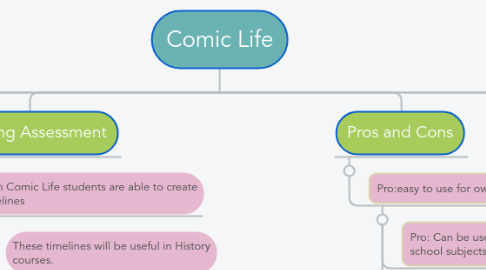
1. Learning Assessment
1.1. With Comic Life students are able to create timelines
1.1.1. These timelines will be useful in History courses.
1.1.1.1. Teachers can assess the students by having them create either broad timelines that are focusing on ideas such as ALL wars in America. Or these timelines could be more specific, and be focused on certain events within a particular war.
1.2. Students can be assessed on their understanding of organization in writing.
1.2.1. Parts of a story: beginning, middle, and end.
1.2.1.1. Teachers can assess the students knowledge on this by asking them to create a short comic book and label where the story changes from beginning, middle, and the end. For older students, teachers could even have them label the climax and resolution of their story.
1.2.1.1.1. Another way that is very similar to the above assessment, would be to have students create their short stories and then give them to other students to identify the beginning, middle, and end.
1.2.2. The flow of events in a story.
2. Teacher Roles
2.1. Facilitate the engagement of students using Comic Life
2.1.1. Make a prototype of a Comic Life to show students what they need to do in order to complete the activity at hand.
2.2. Assess students on content.
2.3. Makes writing and learning activities fun and engaging for students.
3. Learning Goals
3.1. Students will learn interpersonal communication skills
3.1.1. To accomplish this goal, the whole class should work together to get students communicating with each other
3.2. Students will learn a different writing style
3.2.1. Comic Life allows students to write in a comic format, rather than essay or outline format
3.2.2. The comic format requires more creativity and visual learning
4. Learning Activities
4.1. Collaborative Digital Graphic Writing: Students can use pictures, colors, and text to create a sequential images to tell a story
4.2. This can be used for history timelines, scientific methods, or recreating a storyline in their own words.
4.3. Comic life in history:
4.3.1. This can be a fun way for students to understand history. Reading straight from a textbook isn't fun at any age. Being able to see events in History with pictures and speech bubbles would help students retain more information because it is delivered to them in a more interesting manner.
4.4. The whole class can participate in creating a comic life illustration to help them develop interpersonal skills by inferencing different methods of writing learned from their classmates.
4.5. Comic Life in Science:
4.5.1. Comic Life could be used in Science because teachers could put together a comic book of the experiment. This would be helpful for elementary school kids because the directions can be written, but there can also be pictures for them to make reference too.
4.5.1.1. By doing this it could allow the students more freedom on the experiment. Small groups could go do the experiment without a ton of supervision, or the teacher just demonstrating in front of the class.
5. Description
5.1. Allows students to demonstrate their understanding of a concept in a creative way
5.2. Teachers use Comic Life when they want their students to become better writers and be creative.
5.3. Allows students to reflect learning through images/cartoons with a small amount of text
6. Pros and Cons
6.1. Pro:easy to use for own creations
6.1.1. Pro: Can be used for many different school subjects
6.1.2. Cons: It can be a distraction and students may veer of task creating what they want rather than what they need to
6.1.2.1. Cons: It can get distracting if topic goal does not stick with them, making it more time consuming then need be
